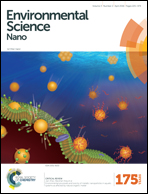Toxic interactions of different silver forms with freshwater green algae and cyanobacteria and their effects on mechanistic endpoints and the production of extracellular polymeric substances†
Abstract
This study investigated the magnitude and mechanisms of toxicity that ionic silver and two silver nanoparticles (AgNPs) of differing size and stabiliser imparted on two model organisms, green algae (Chlamydomonas reinhardtii) and cyanobacteria (Synechococcus leopoliensis), and their effect on the extracellular polymeric substances (EPS) produced. Major silver losses were detected during the 72 h of exposure compared with introduced nominal concentrations. Cell viability and production of reactive oxygen species (ROS) were investigated to assess mechanisms of toxicity. All silver forms had a significant effect on viability for C. reinhardtii but only ionic silver significantly affected ROS production. For S. leopoliensis, only ionic silver affected viability. Levels of EPS produced by both species were similar between all treatments. Compositional differences were noted for C. reinhardtii with greater levels of lower molecular weight material produced in the presence of all silver forms. The results indicate that ionic silver has the greatest effect on the toxic stress endpoints. Variations between the ionic control and the two AgNP treatments are possibly due to differences in the ionic release dynamics and interactions with EPS produced by microorganisms. S. leopoliensis showing greater reduction in growth rates but lower impact on viability and ROS than C. reinhardtii is likely related to differences in relevant biological properties such as size and cell wall composition.


 Please wait while we load your content...
Please wait while we load your content...